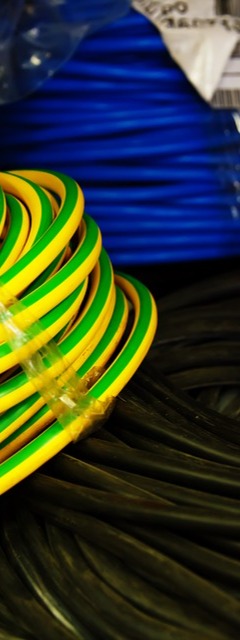Share this
by Simcona on Sep 4, 2024 12:15:00 PM
5. Corrosion Resistance
Corrosion comes in many forms in an industrial environment: moisture, chemicals, oil, and UV light. To source a corrosion-resistant cable, consider:
- What corrosives may be present
- How much concentration (intensity) of the corrosive may appear
- How long exposure may last
The cable’s coating will be influential here, ideally keeping the assembly safe and reliable for years to come.
Moisture
Hazards: Reduced insulation integrity, conductor corrosion, short-circuiting, electrical failure.
Solutions: TPU, cross-linked polyethylene (XLPE), polypropylene
Chemicals
Hazards: Corrosion, loss of mechanical and electrical properties
Solutions (depending on specific chemicals involved): FEP, PTFE, TPEs such as Santoprene
Oil
Hazards: Swelling, softening, degradation, loss of electrical properties, failure
Solutions: Polyurethane, EPR, silicone rubber
UV
Hazards: Degradation and deterioration of insulation, reduced electrical performance, brittleness, insulation failure
Solutions: XLPE, TPE, EPR
6. Processability
This one’s about efficiency of production.
- Will the wire require processing such as stripping or cutting?
- Will processing be done by hand or with an automated machine?
- Will your desired cabling be easy to strip or terminate?
Consider the strippability of potential cable purchases to save time and effort during production, installation, and repairs. The last thing you want is to automate a process, only for the production line to slow to strip each wire entering the machine.
Some cables have specially designed insulation that allows for effortless stripping.
- EPR (ethylene propylene rubber)
- Silicone
- Polyurethane
- Other thermoplastics
Note that the hardness of certain materials, like PVC, may differ between manufacturers and affect ease of processing. Different equipment may produce different results, but making machine adjustments can typically accommodate these variations.
7. Price
Price shouldn’t be the sole factor when buying control, supply, and other cables, but it’s an important consideration (unless your budget’s infinite).
Consider the needs of your design, your budget manager, and your customers:
- Specifications – Match your investment level to the caliber of voltage rating, flexibility, and length you need.
- Long-term performance – If you’re building equipment whose failure could result in catastrophe or death, don’t automatically buy the cheapest wire. Even in less-dangerous situations, it may be more cost-effective to buy expensive cabling that’ll last longer in rugged environments. Don’t forget to include maintenance and downtime costs.
- Sourcing partnership – Rely on a full-service distributor with experience in your market. It can recommend cheaper alternatives, prepare for demand spikes so you don’t overpay, and pass down bulk discounts.
Nobody wants to get ripped off, but when you’re sourcing heavy-duty cables, you need heavy-duty materials and engineering. Those come with a cost.
8. Availability
Ensure that the cable materials you spec are readily available in the quantities you need. Or, if they are obscure ones, at least use a distributor with a vast supplier network and track record of resourcefulness and preparedness.
This ensures easy replacements and expansions in the future, preventing unnecessary downtime and redesigns.
Frequently Asked Questions:How do I determine the appropriate cable gauge for my specific application needs beyond just electrical load and length? To determine the appropriate cable gauge for your application, you should consider several additional factors beyond electrical load and length. These include the ambient temperature of the environment where the cable will be installed, as higher temperatures can increase resistance and necessitate a thicker gauge. You should also account for any potential voltage drops over long distances, which may require a larger gauge to maintain efficiency. Furthermore, the cable's exposure to mechanical stresses and potential physical damage can influence the choice of gauge. Consulting with a cable manufacturer or an electrical engineer on these specific conditions will help you select the correct gauge for reliable and safe performance. What are the trade-offs between different types of shielding materials in terms of cost, performance, and durability? The trade-offs between different types of shielding materials involve balancing cost, performance, and durability. For instance, aluminum foil shields are cost-effective and offer good EMI protection, but may lack durability in harsh environments. Copper shields provide superior protection against EMI and corrosives, but are more expensive. Conductive polymers and braided shields offer a middle ground with good flexibility and performance, but can also vary in cost and durability based on the specific polymer and braiding technique. How can I assess the long-term reliability of a cable under fluctuating environmental conditions, such as temperatures and exposure to chemicals? Start by reviewing the cable's temperature rating and chemical resistance as specified by the manufacturer to ensure it meets the expected conditions of your application. Also, think about running accelerated aging tests or asking the manufacturer for long-term performance data in similar conditions. Understanding the cable's material composition and how it reacts to temperature variations and chemical exposure over time can provide insights into its durability. Regular maintenance and inspection routines can also help identify any potential issues early and ensure the cable continues to perform reliably. |
Additional Guidance for Buying Cables/Wires
Even among industrial-specific cables, there’s an outrageous number of varieties to sort through. Assuming all options are available at a reasonable cost and lead time, focus your decision on:
- How mechanical & dimensional specs will affect usability
- How robust the electrical signal protection must be
- Environmental factors – temperature, moisture, & chemicals
Stick to those tenets and the eight tips above, and your cables and devices will exist in harmony – in any industrial application.
This article was originally published in June of 2023 and recently updated





Comments (1)